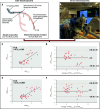Changes in absolute coronary flow and microvascular resistance during exercise in patients with ANOCA
- PMID: 39155757
- PMCID: PMC11317832
- DOI: 10.4244/EIJ-D-24-00247
Changes in absolute coronary flow and microvascular resistance during exercise in patients with ANOCA
Abstract
Background: Whether saline-induced hyperaemia captures exercise-induced coronary flow regulation remains unknown.
Aims: Through this study, we aimed to describe absolute coronary flow (Q) and microvascular resistance (Rμ) adaptation during exercise in participants with angina with non-obstructive coronary artery disease (ANOCA) and to explore the correlations between saline- and exercise-derived coronary flow reserve (CFR) and microvascular resistance reserve (MRR).
Methods: Rμ, Q, CFR and MRR were assessed in the left anterior descending artery using continuous thermodilution with saline infusion at 10 mL/min (rest), 20 mL/min (hyperaemia) and finally at a 10 mL/min infusion rate during stress testing with a dedicated supine cycling ergometer. An incremental workload of 30 watts every two minutes was applied. A saline-derived CFR (CFRsaline) cutoff <2.5 was used to identify coronary microvascular dysfunction (CMD).
Results: CFRsaline-defined CMD was observed in 53.3% of the participants (16/30). While cycling, these patients less of an ability to increase Q (7 [interquartile range [IQR] 30.5-103.0] vs 21 [IQR 5.8-45.0] mL/min/30 watts; p=0.01) due to a smaller decrease of Rμ (109 {IQR 32-286} vs 202 [IQR 102-379] Wood units [WU]/30 watts; p<0.01) as compared with the group with normal CFRsaline. In the overall population, CFRsaline and exercise-derived CFR (CFRexercise) were 2.70±0.90 and 2.85±1.54, respectively, with an agreement classification of 83.3%. A good correlation between saline and exercise techniques for both CFR (r=0.73; p<0.0001) and MRR (r=0.76; p<0.0001) was observed. Among participants with normal CFRsaline, 28.7% (4/14) had an impaired CFRexercise <2.5 at the peak of exercise due to a moderate and late decrease of Rμ.
Conclusions: Saline-induced hyperaemia provided a valid surrogate for exercise physiology independently of the absolute level of CFR and MRR, although exercise provided more granularity to evaluate adaptation among participants with exercise-related CMD.
Conflict of interest statement
M. Zeitouni received research grants and honorarium from Bayer, BMS-Pfizer, la Fédération Française de Cardiologie, Servier, AstraZeneca, Novo Nordisk, and Abbott. J. Silvain received research grants and honorarium from AstraZeneca, Bayer Healthcare SAS, Abbott Medical France SAS, Biotronik, Boehringer Ingelheim France, CSL Behring, Gilead Science, and Sanofi-Aventis France; and has been a stockholder of PharmaSeeds, Terumo France SAS, and Zoll. G. Montalescot received research grants and honorarium from Abbott, Amgen, AstraZeneca, Ascendia, Bayer, Bristol-Myers Squibb, Boehringer Ingelheim, Boston Scientific, CeleCor, CSL Behring, Idorsia, Lilly, Novartis, Novo Nordisk, Opalia, Pfizer, Quantum Genomics, Sanofi, and Terumo. The other authors have no conflicts of interest to declare.
Figures




References
-
- Jespersen L, Hvelplund A, Abildstrøm SZ, Pedersen F, Galatius S, Madsen JK, Jørgensen E, Kelbæk H, Prescott E. Stable angina pectoris with no obstructive coronary artery disease is associated with increased risks of major adverse cardiovascular events. Eur Heart J. 2012;33:734–44. - PubMed
-
- Sara JD, Widmer RJ, Matsuzawa Y, Lennon RJ, Lerman LO, Lerman A. Prevalence of Coronary Microvascular Dysfunction Among Patients With Chest Pain and Nonobstructive Coronary Artery Disease. JACC Cardiovasc Interv. 2015;8:1445–53. - PubMed
-
- Kelshiker MA, Seligman H, Howard JP, Rahman H, Foley M, Nowbar AN, Rajkumar CA, Shun-Shin MJ, Ahmad Y, Sen S, Al-Lamee R, Petraco R Coronary Flow Outcomes Reviewing Committee. Coronary flow reserve and cardiovascular outcomes: a systematic review and meta-analysis. Eur Heart J. 2022;43:1582–93. - PMC - PubMed
MeSH terms
LinkOut - more resources
Full Text Sources
Medical

